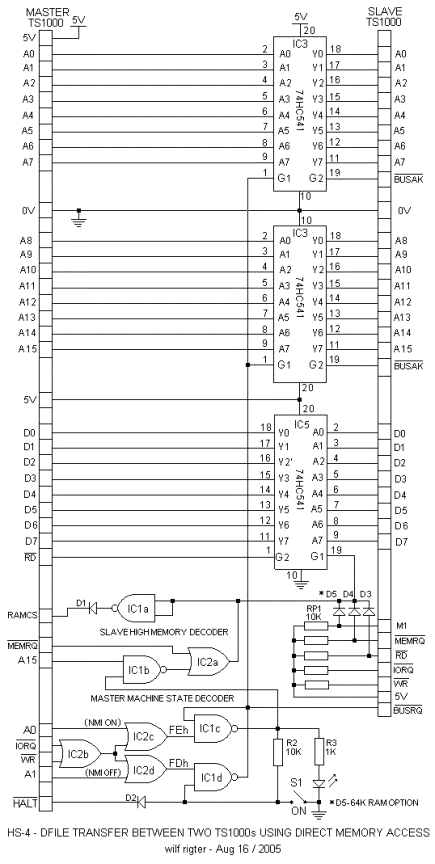HIGH
SPEED INTERFACE 4
August 16, 2005 - wilf rigter
INTRODUCTION
The
HS-4 system is a high speed interface between two TS1000 units,
one of
which is dedicated to executing a user program in the FAST
mode
while the other generates a continuous video display of the
user
program DFILE.
HS-4 OUTLINE
The
Master TS1000 provides a SLOW mode video display of the application
program
running in the FAST mode on the Slave TS1000.
The
Slave DFILE is directly transferred to Master DFILE through an
memory
mapped HS-4 interface. This is the fastest method short of using
a true
DMA chip but the HS-4 is conceptually much simpler to work with.
The
HS-4 interface provides the Master TS1000 with Direct Memory Access
to the
echo between 48K and 64K of the 16K Slave BASIC MEMORY including
the
SYSTEM VARIABLES, PROGRAM and DFILE. If a 64K memory pack is used D6
must be
installed which asserts M1 to enable the echo of the 16K to 32K
BASIC
RAM page above 32K.
The
Master takes control of the SLAVE memory by using BUSRQ with contents
Directly
addressed by 16 bit address and SLAVE DFILE data is transferred
directly
to the MASTER DFILE using a single LDIR machine code instruction.
HS-4 CONTROL SOFTWARE
The control
software that runs on the MASTER TS1000 is a short MC program
The
SLAVE System Variable DFILE echo is loaded into HL with the MSB set.
The
MASTER System Variable DFILE is loaded into register DE.
The
length of a full DFILE is 793d (319h) which is loaded into register BC.
the
DFILE is transferred using a single MC instruction LDIR.
Repeat.
LOOP LD HL,(C00C)
; LOAD SLAVE SYSTEM VARIABLE DFILE ECHO INTO HL (SOURCE)
SET bit 7, H ; SET MSB ADDRESS
BIT (+32K) TO ACCESS SLAVE DFILE ECHO
LD DE,(400C) ; LOAD MASTER
SYSTEM VARIABLE DFILE INTO DE (DESTINATION)
LD BC, 0319h ; LOAD SIZE
OF FULL DFILE (931 bytes) INTO BC (LENGTH)
LDIR ; TRANSFER
JR LOOP ; REPEAT
That’s
it.
HS-4 HARDWARE
The
HS-2 design uses five simple TTL chips.
74HC32
OR gates and 74HC00 NAND gates are used for the MASTER Machine State
Decoder
whose state indicates whether the MASTER CPU is running the video
routines
or the control program. When generating video, the MASTER only
controls
the internal 2K of RAM. When the MASTER is free to run the control
program,
the MS decoder automatically takes control of the SLAVE CPU and the
SLAVE
BASIC RAM above 32K which is then directly accessible to the MASTER CPU.
The MS
decoder decodes the Machine State from the MASTER NMI ON and OFF I/O
commands.
The MS Decoder is the same circuit used in the TurboV2 clock-doubler
to
decode when the user program is running and the CPU clock can be doubled.
Two
74HC541 octal buffers are used as 16 bit address buffers and are enabled
by both
BUSRQ and BUSACK.
A third
74HC541 is used as an 8 bit data buffer is controlled by both the
MASTER RD
line and the High Memory decoder circuit that uses A15, MREQ,
and BUSREQ
to enable the data buffer. When the MASTER control program is
running
and SLAVE data is read above 32K, the data buffer is active and
while the
MASTER internal 2K RAMCS line is
disabled with D1.
The
control hardware and software runs on the Master TS1000. The Master
runs in
the SLOW mode and spends most CPU time executing video routines.
When
the CPU is free to run the control program, the machine state decoder
asserts
the BUSRQ signal on the Slave TS1000 bus. The Slave CPU responds
with
BUSACK, which enables the IC3-IC4 the buffers that connect the MASTER
address
bus to the Slave memory. The Master then reads the data byte at
at any
address above 32K from the SLAVE memory through U5, the data input
port
and transfers the byte to the Master memory
The
time to transfer one byte using LDIR is about 6.5 us, so a complete
DFILE
can take up to 793 x 6.5us = 5ms of CPU time. Since the transfer
will be
interrupted during the SLOW video display time, the total time to
transfer
DFILE is 1 to 3 frames depending on the vertical frame rate.
The
Master Machine State decoder automatically drops the BUSRQ line
during
the video display, which allows the SLAVE user program to
resume
execution.
In
fact, the Slave user program only runs when the Master TS1000 is
generating
the video display which means that the Slave user program uses
more
than 80% of available Slave CPU time at 60 Hz vertical frame rate.
This
means that the FAST TS1000 user program runs 3 times faster than the
normal
50Hz SLOW mode and 5 times faster than the normal 60HZ SLOW mode.
The
LDIR instruction increments addresses during the DFILE transfer which
avoids problems
if DFILE is not properly formatted (eg after SCROLL).
I like the HS-4 solution the best and I will actually build the HS-4 prototype
first to get baseline information on the performance of this type of interface.

COMMENTS
Circuit detailed
operation to come
REVISION NOTES